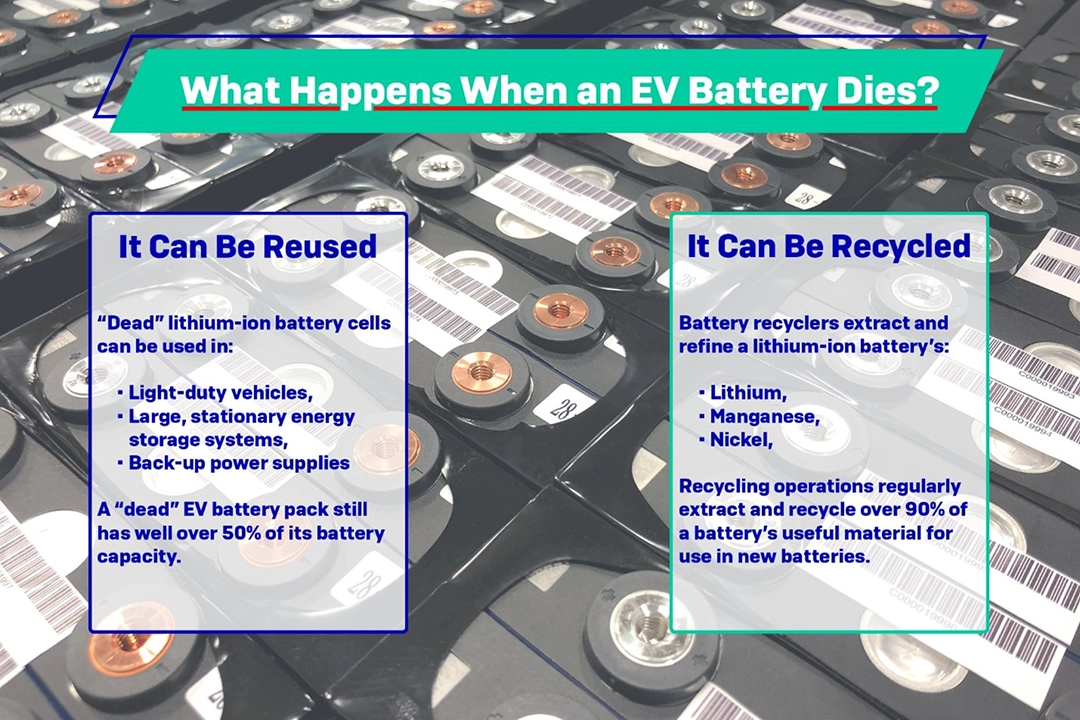
Posted July 4th, 2022
WHAT HAPPENS AFTER AN ELECTRIC VEHICLE BATTERY DIES?
Proper charging and maintenance habits can keep an electric vehicle’s battery pack running for well over a decade. At some point, however, the battery pack will need to be replaced. So, what happens to an EV battery after it’s taken out of the vehicle?
The two most effective ways to manage these spent lithium-ion battery packs is to reuse and recycle them.
Reuse
An electric vehicle battery pack is at the end of its service life when its capacity lowers by 20 to 30%. From this point onward, each charge-discharge-charge cycle will lower the battery capacity even further and the pack is no longer suitable for powering the vehicle.
Just because that battery pack is no longer suited for an electric vehicle, however, does not mean that the battery is “dead.” These battery packs still contain well over half of their storage capacity when they are deemed unfit for use in a vehicle. In some instances, these batteries can be directly repurposed to power light-duty vehicles or industrial equipment. Often, spent EV batteries find new life in energy storage systems. Depending on the state of the batteries, they may be integrated into large, stationary energy storage systems, such as solar panel grids, or into commercial and personal energy solutions, such as back-up power supplies.
Experts estimate that a spent EV battery pack could be reused for at least ten years. Not only would this effectively double the battery pack’s lifespan, but, because it emits zero operating emissions, would greatly reduce its overall carbon footprint.
Recycle
Once repurposing a used lithium-ion battery pack is no longer feasible, the next step is to recycle it. The battery cell housing (steel, aluminum, plastic, etc.) can all be easily retrieved and recycled for use in other settings. Moreover, the lithium, manganese, nickel, and other elements found in the battery cells can be recovered and refined for a multitude of different uses, including use in future EV batteries.
Since 2017, German recycling company Duesenfeld has demonstrated the ability to consistently recycle over 90% of used lithium-ion battery material. The company’s recycling method forgoes high-temperature thermal processing, reducing their overall CO2 emissions during the recycling process.
Duesenfeld aren’t the only players either; the recycling process for lithium-ion batteries is already spreading worldwide. Canadian recycling company Li-Cycle currently process over 5,000 tonnes of used lithium-ion batteries per year, with the ability to extract over 95% of the battery’s usable materials.

Whether it’s for commercial or personal use, the popularity of electric vehicles is steadily on the rise. After hitting record-high sales numbers in 2021, industry specialists anticipate at least 145 million EVs to be on the road by 2030. With these projections, it’s critical to plan for what to do with an electric vehicle battery pack after it has reached the end of its service life. The current methods of reusing and recycling lithium-ion batteries already show tremendous promise and must continue to grow alongside the demand for electric vehicles.
Header Image Recycle Reduce Reuse by Kevin Dooley